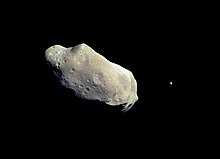Double asteroid

A double planetoid or double asteroid is a system of two gravitationally bound asteroids that move around a common center of gravity . Is a body significantly larger than the other, then one speaks generally of the moon or satellite of the asteroid or by an asteroid moon or Planetoidenmond . From a railway mechanical perspective, such a system is comparable to the earth-moon system or with double stars .
In contrast to the double asteroid, one speaks of an asteroid pair when there is no gravitational bond (any longer), but a common origin less than 1 million years ago in the heliocentric orbital elements is calculated.
Proportions
In principle, there are no restrictions on the size relationships between the main body and companion. Two bodies of approximately the same size are possible (ratio approx. 1: 1; examples: (617) Patroclus , (58534) Logos ) as well as bodies with a volume ratio of approx. 2500: 1, as in the example (243) Ida and Dactyl can be seen (for comparison, the earth : moon volume ratio is around 50: 1). (243) Ida was the first asteroid known to have a companion.
Period of circulation
Due to the comparatively low mass of the asteroids, the resulting maximum distance for stable orbits is often only a few multiples of the diameter of the main body. This short distance in turn leads to a short orbit period (often more than one cycle per day).
Emergence
Due to the close proximity to each other, it is assumed that both bodies are made of the same material and were created next to each other at the same time, or that both once formed one body from which a part separated due to rotation or an impact.
example
The double asteroid (175706) 1996 FG 3 has a volume ratio (main body: companion) of 42: 1 and an average distance of 3 km (2 to 3 times the diameter of the main body). The orbital period of the companion around the barycenter is 16.2 hours. (175706) 1996 FG 3 was initially selected as the main target for the ESA mission MarcoPolo-R , during which a landing on the main body and a sample return from the asteroid back to earth are to be carried out. Meanwhile the single asteroid (341843) 2008 EV 5 is the goal.
